

Creating an AVI from a series of images - Windows — Continuum Mechanics, Image analysis, Signal processing and System Identification. This tutorial will describe a method of compiling a series of images saved from CMGUI into an AVI format movie file on the Windows operating system. There are other methods, but the one described here can be achieved easily, with free software, and produces excellent and highly customizable results. An AVI file is a Windows format - however, it can be played on most computers including those running Mac OS X or Linux.
It can also be uploaded to online video sites such as YouTube. Compiling a series of images into a movie When making a movie from a sequence of images, it is important to make sure that the images you created in CMGUI are saved at a usable resolution. Creating a movie from a series of images using VirtualDub is very simple: Load VirtualDub. Critical Halloween Architecture Costume Competition. On October 29, Storefront for Art and Architecture will host Critical Halloween: On Banality, An Architecture Costume Party, at 3-Legged Dog in Lower Manhattan.

The competition portion will continue on DomusWeb through November 11th. At Critical Halloween, artists, architects and all creative individuals in New York are called upon to exercise their critical judgment and creative action against one of the most feared ghosts of artistic and architectural production: Banality. Architects Create Design-Themed Costumes for Storefront for Art & Architecture's Halloween Party. Stormy weather couldn’t keep guests away from dressing to the nines and traveling to the West Village where they entered a fantastical room filled with Christian Wassman air dressing balloons and Fellini’s 8 1/2 playing along the walls.

Banality themed costumes ranged from the mundane like stick figures, scale models, an X-acto knife, to an architect’s evil challenges like sheet rock, critical mass, and greedy profiteers. Architizer CEO Marc Kushner attended the festivities dressed as a Photoshop lasso tool, and there were even a couple iconic King Kong and Empire State Building duos, including Bjarke Ingles as a King Kong. Though there was a live competition the night of the party, votes are still being collected for the people’s choice favorite costume online. Prizes include a print by architectural photographer Dean Kaufman, a print by Madelon Vriesendrop, a drawing by Ryue Nishizawa, and a year long membership to Storefront.
Vote for your favorite costume HERE until November 11th! Architecture Costume Parties: A Primer. Cutting out the cubes. How to weave a cube out of paper. Weave three strips of paper with the same over-and-under pattern as you would use to braid hair and you will create a cube.
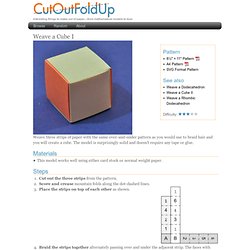
The model is surprisingly solid and doesn't require any tape or glue. Materials This model works well using either card stock or normal weight paper. Steps Cut out the three strips from the pattern. Place the strips on top of each other as shown. Notes John Gorham developed the technique of weaving polyhedra to make models that are useful when studying crystallography. Links John Gorham's book is now in the public domain and is available online. References (Gorham 1888) (Pargeter 1959) Comments. Musculoskeletal System - Biology Encyclopedia - body, human, specific, membrane, water, produce, common, first. Photo by: Alila.
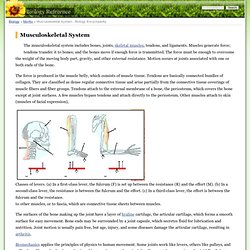
Head and neck anatomy. Head and neck anatomy focuses on the structures of the head and neck of the human body, including the brain, bones, muscles, blood vessels, nerves, glands, nose, mouth, teeth, tongue, and throat.

It is an area frequently studied in depth by surgeons, dentists, dental technicians, and speech language pathologists. Musculoskeletal system[edit] P1160648-Neck_bones,_3D_CT_scan-SPL.jpg (365×530) 67471.jpg (280×263) 8638096-3d-render-of-a-male-medical-skeleton-with-a-close-up-of-the-neck-bones.jpg (391×400) Human eye. The human eye is an organ that reacts to light and has several purposes.
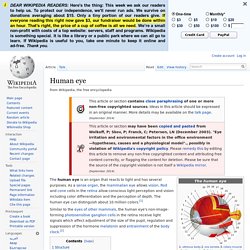
As a sense organ, the mammalian eye allows vision. Rod and cone cells in the retina allow conscious light perception and vision including color differentiation and the perception of depth. The human eye can distinguish about 10 million colors.[1] Structure[edit] Visual perception. Visual perception is the ability to interpret the surrounding environment by processing information that is contained in visible light.
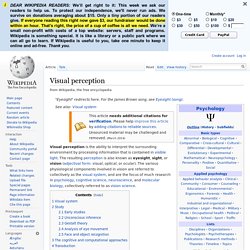
The resulting perception is also known as eyesight, sight, or vision (adjectival form: visual, optical, or ocular). The various physiological components involved in vision are referred to collectively as the visual system, and are the focus of much research in psychology, cognitive science, neuroscience, and molecular biology, collectively referred to as vision science.
Visual system[edit] Main article: Visual system. Lens (optics) A biconvex lens.
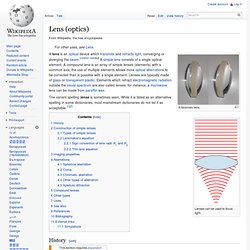
Lenses can be used to focus light. The variant spelling lense is sometimes seen. While it is listed as an alternative spelling in some dictionaries, most mainstream dictionaries do not list it as acceptable.[1][2] The oldest lens artifact is the Nimrud lens, dating back 2700 years to ancient Assyria.[3][4] David Brewster proposed that it may have been used as a magnifying glass, or as a burning-glass to start fires by concentrating sunlight.[3][5] Another early reference to magnification dates back to ancient Egyptian hieroglyphs in the 8th century BC, which depict "simple glass meniscal lenses".[6][verification needed] Excavations at the Viking harbour town of Fröjel, Gotland, Sweden discovered in 1999 the rock crystal Visby lenses, produced by turning on pole lathes at Fröjel in the 11th to 12th century, with an imaging quality comparable to that of 1950s aspheric lenses.
Between the 11th and 13th century "reading stones" were invented. More complex are aspheric lenses. Mouth. Speech. Speech is the vocalized form of human language.

It is based upon the syntactic combination of lexical and names that are drawn from very large (usually about 10,000 different words) . Each spoken word is created out of the phonetic combination of a limited set of vowel and consonant speech sound units. These vocabularies, the syntax which structures them, and their set of speech sound units differ, creating the existence of many thousands of different types of mutually unintelligible human languages. Most human speakers are able to communicate in two or more of them,[1] hence being polyglots. The vocal abilities that enable humans to produce speech also provide humans with the ability to sing. Elocution. History[edit] In Western classical rhetoric, elocution was one of the five core disciplines of pronuntiatio, which was the art of delivering speeches.

Orators were trained not only on proper diction, but on the proper use of gestures, stance, and dress. (Another area of rhetoric, elocutio, was unrelated to elocution and, instead, concerned the style of writing proper to discourse.) With the publication of these works and similar ones, elocution gained wider public interest. While training on proper speaking had been an important part of private education for many centuries, the rise in the nineteenth century of a middle class in Western countries (and the corresponding rise of public education) led to great interest in the teaching of elocution, and it became a staple of the school curriculum. Sample curriculum[edit] Enunciation. Sound. A drum produces sound via a vibrating membrane. Sound is a vibration that propagates as a mechanical wave of pressure and displacement, through some medium (such as air or water). Sometimes sound refers to only those vibrations with frequencies that are within the range of hearing for humans[1] or for a particular animal.
Acoustics[edit] Acoustics. Acoustics is the interdisciplinary science that deals with the study of all mechanical waves in gases, liquids, and solids including vibration, sound, ultrasound and infrasound. A scientist who works in the field of acoustics is an acoustician while someone working in the field of acoustics technology may be called an acoustical engineer. The application of acoustics is present in almost all aspects of modern society with the most obvious being the audio and noise control industries.
The word "acoustic" is derived from the Greek word ἀκουστικός (akoustikos), meaning "of or for hearing, ready to hear"[2] and that from ἀκουστός (akoustos), "heard, audible",[3] which in turn derives from the verb ἀκούω (akouo), "I hear".[4] The Latin synonym is "sonic", after which the term sonics used to be a synonym for acoustics[5] and later a branch of acoustics.[6] Frequencies above and below the audible range are called "ultrasonic" and "infrasonic", respectively. Ear. Structure. Hearing aid. In-ear hearing aid A hearing aid is an electroacoustic device which is designed to amplify sound for the wearer, usually with the aim of making speech more intelligible, and to correct impaired hearing as measured by audiometry.
In the United States, Hearing aids are considered medical devices and are regulated by the Food and Drug Administration (FDA). Ordinary small audio amplifiers or other plain sound reinforcing systems cannot be sold as "hearing aids". History[edit] Hearing (sense) Hearing.